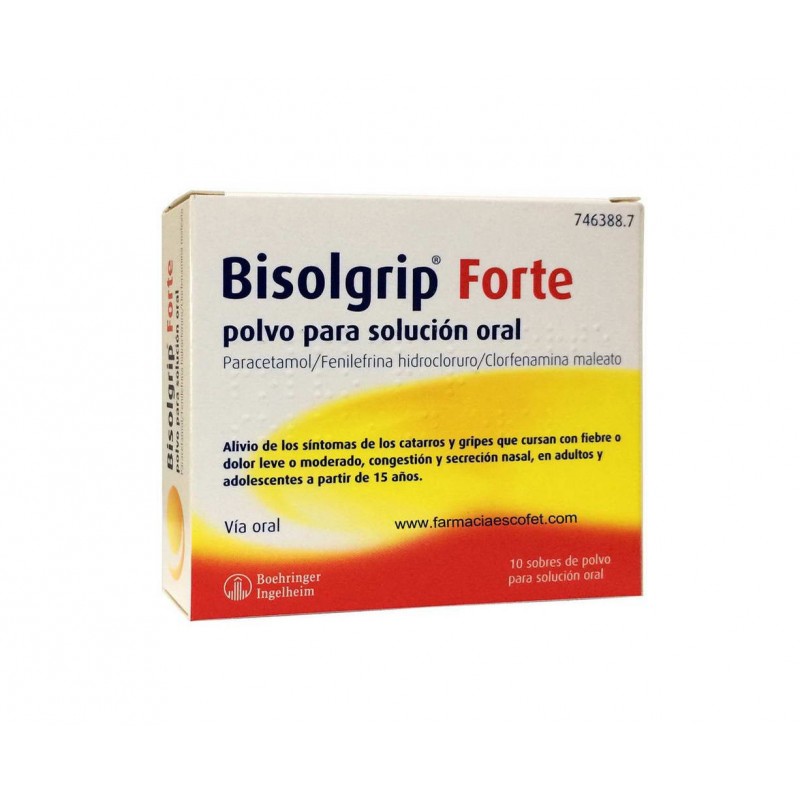



Relief of symptoms of colds and flus that occur with fever or mild to moderate pain, congestion and runny nose in adults and adolescents from 15 years
What Bisolgrip Forte is and what it is used for
It is an association of paracetamol, chlorphenamine and phenylephrine.
Acetaminophen is a pain reliever that reduces pain and fever.
Chlorphenamine is an antihistamine that relieves a runny nose.
Phenylephrine is a sympathomimetic that reduces nasal congestion.
It is indicated for the relief of symptoms of colds and flu that occur with fever or mild or moderate pain, congestion and runny nose, in adults and adolescents from 15 years.
You should see a doctor if it worsens or does not improve or if the fever persists for more than 3 days or pain for more than 5 days.
How to take Bisolgrip Forte
Always take this medicine exactly as described in this leaflet or as your doctor or pharmacist has told you. If in doubt ask your doctor or pharmacist.
The recommended dose is:
Adults and adolescents from 15 years: 1 envelope every 6-8 hours as needed (3 or 4 envelopes per day). Do not take more than 4 sachets (equivalent to 2.6 g of paracetamol) in 24 hours.
Patients with hepatic impairment: These patients cannot take more than 1 in every 8 hours. In no case may they take more than 3 sachets a day.
If liver failure is severe they cannot take this medicine.
Patients with kidney failure: They cannot take this medicine due to the dose of paracetamol. This medication is contraindicated.
Gilbert Syndrome patients: These patients should consult a doctor before taking this medicine as a dosage adjustment may be necessary.
Use in children and adolescents
This medication is contraindicated in children and adolescents under the age of 15.
Use in older people
Elderly people can not use this medicine without consulting the doctor because some adverse effects of the medicine such as the appearance of slow heartbeats (bradycardia) or the reduction of the cardiac output, due to the content of phenylephrine and chlorphenamine, can especially affect them. They are also more likely to have adverse effects such as sedation, confusion, hypotension, or arousal, and may be more sensitive to effects such as dry mouth and urinary retention.
How to drink
Bisolgrip Forte is taken orally.
Completely dissolve the contents of the envelope in a little liquid, preferably in half a glass of water and then drink.
Always take the lowest dose that is effective.
Taking this medicine is subject to the appearance of symptoms. As these disappear, treatment should be discontinued.
If the fever continues for more than 3 days of treatment, pain or other symptoms for more than 5 days, or if new symptoms worsen or appear, you should see your doctor.
If you take more Bisolgrip Forte than you should
If you have ingested an overdose, you should immediately go to a medical center even if you do not notice the symptoms, since these often do not manifest until 3 days after ingestion of the overdose, even in cases of severe poisoning.
Older people, children, people with liver disease, who consume alcohol or are chronically malnourished, or treated with enzyme-inducing medications are at increased risk of poisoning, including death.
Overdose symptoms may be: nausea, dizziness, vomiting, loss of appetite, pale discoloration of the skin and eyes (jaundice), and abdominal pain. Anxiety, fear, agitation, headache (may be a symptom of high blood pressure), seizures, insomnia (or severe drowsiness), clumsiness, fainting, instability, confusion, irritability, tremors, anorexia; psychosis with hallucinations (the latter especially in children). Dry mouth, nose, or throat.
Effects such as high blood pressure, arrhythmias (fast or irregular heartbeat), palpitations, myocardial infarction, reduced urine output. Metabolic acidosis (decrease in the alkaline reserve of the blood). In prolonged use, plasma volume depletion may occur (decrease in blood volume). It can also cause hepatic cytolysis causing liver failure, gastrointestinal bleeding, encephalopathy, disseminated intravascular coagulation, coma and death. Pancreatitis, acute kidney failure and pancytopenia may also appear,
Treatment of taking an overdose is most effective if started within 4 hours of taking the drug overdose.
In case of overdose or accidental ingestion, immediately go to a medical center or call the Toxicological Information Service (Telephone 91 562 04 20), indicating the medication and the amount ingested.